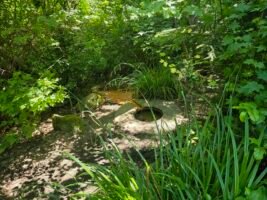“Yaquina Head’s light is 81’2” (25 m) above the ground and 162′ (49 m) above mean sea level; the top of the tower is 10′ (3 m) higher still. Higher is better – On America’s rugged west coast, keeping lights low enough to be seen under the fog was often a problem. However, if they were placed too low, they couldn’t be seen far enough away to be useful. The higher a light is, the further it can be seen at sea. At 162 feet (49 m) above sea level, Yaquina Head’s light can be seen about 19 miles (32 km) out to sea. Late nights at the office – Imagine spending all of a long winter’s night sitting on a stiff chair 70 feet (21 m) up in the tower watching the light. Now try to imagine doing it in the years before there was radio, tv, or even electricity! The buildings attached to the light tower have two rooms which once served as the ‘oil room and office’ however the keepers stood nightly watch in the tower itself. Still lighting the way: Many ships and boats continue to depend on lighthouses for navigational aid. Equipment in the small building attached to the light tower keeps a light on in case the electricity fails. A small battery-powered backup light is attached to the railing surrounding the lantern deck – you can see it from the observation deck at the base of the tower.
By modern standards, the regular routine of a lighthouse keeper was monotonous. It was however sometimes interrupted by unexpected moments of drama. ‘last night lightning struck the office and storeroom building. it tore off the copper, lead, and shingles where the root joins on to the tower …’ keeper’s log, Yaquina head, Oct 18, 1920. By 10 am every day the lighthouse lamp was refueled and its five wicks trimmed. Throughout the day, the lens and windows were cleaned and repairs were made to keep everything shipshape. At dusk, the lamp was lit and then watched from the watch room until sunrise. What else did keepers do? they greeted tourists ‘ … sea quite smooth. keepers painting the watch room and working the road today, had two visitors today.’ – keeper’s log Yaquina head, April 28, 1877.
They submitted to inspections: ‘…they never knew when an inspector was going to come. He came about four times each year. He would just come in the house as he belonged there and he would go through it just to see if the women kept the houses up.’ – Philena Nelson, a friend of the keeper’s children 1916-1918. They painted and painted some more ‘ keepers painting the brackets and getting stage (scaffold) ready and mixing paint to paint towers’ – keeper’s long, Yaquina head, May 27, 1891. They aided victims of shipwrecks – ‘keeper sends 2nd asst. to Newport for the assistance of a tug. The keepers gave the three men that got ashore necessary assistance done all in their power to make them comfortable’-Keeper’s long, Yaquina Head, March 28, 1889. Even though Newport was only four miles away, bad weather, poor roads, and the demands of their work combined to tie the keepers and their families to the Yaquina Headlight station. They caught, shot, and grew their own food. ‘Keepers whitewashing the garden fence and weeding the garden also today.’ June 8, 1887. They coped with the weather – when there were big storms and the seas were rough, it would make a roar and shae the lighthouse. the spray from the ocean, when the waves were rough, would spray clear up to the tower. Some of the women became keeps – Mrs. M J Plummer went on duty as a laborer today until a 2nd Asst. arrives at the station.’ August 17, 1888. In the long history of staffed US lighthouses, a number of women, usually wives or daughters of keepers served as keepers. “~ information sign at Yaquina Head National Park, Newport, Oregon.
































![Starbucks: The Rise, the Stumbles, and the Loyal Addict’s Story [2025 Update]](https://technowanderer.com/wp-content/uploads/2024/02/starbuck-2363703_1280-267x200.jpg)
